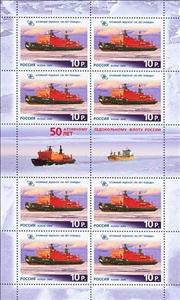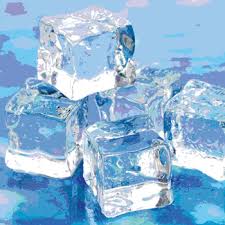Mini Sheet: Nuclear Ice-Breaker "50 Let Pobedy", 2007 (Russia 2009)
Nuclear Ice-Breaker "50 Let Pobedy", 2007 (Russia 2009)
18 June (Russia ) within release 50th Anniversary of Russian Nuclear Ice-Breakers goes into circulation Mini Sheet Nuclear Ice-Breaker "50 Let Pobedy", 2007 face value 80 Russian ruble
| Mini Sheet Nuclear Ice-Breaker "50 Let Pobedy", 2007 in catalogues | |
|---|---|
| Michel: | Mi:RU 1555Klb |
Mini Sheet is vertical format.
Also in the issue 50th Anniversary of Russian Nuclear Ice-Breakers:
- Stamp - Nuclear Ice-Breaker "Lenin", 1959 face value 7;
- Mini Sheet - Nuclear Ice-Breaker "Lenin", 1959 face value 8*7;
- Stamp - Nuclear Ice-Breaker "Taimyr", 1989 face value 8;
- Mini Sheet - Nuclear Ice-Breaker "Taimyr", 1989 face value 64;
- Stamp - Nuclear Ice-Breaker "Yamal", 1992 face value 9;
- Mini Sheet - Nuclear Ice-Breaker "Yamal", 1992 face value 72;
- Stamp - Nuclear Ice-Breaker "50 Let Pobedy", 2007 face value 10;
- Mini Sheet - Nuclear Ice-Breaker "50 Let Pobedy", 2007 face value 80;
Mini Sheet Nuclear Ice-Breaker "50 Let Pobedy", 2007 it reflects the thematic directions:
A ship is a large watercraft that travels the world's oceans and other sufficiently deep waterways, carrying passengers or goods, or in support of specialized missions, such as defense, research and fishing. Historically, a "ship" was a sailing vessel with at least three square-rigged masts and a full bowsprit. Ships are generally distinguished from boats, based on size, shape and load capacity.
A tanker (or tank ship or tankship) is a ship designed to transport or store liquids or gases in bulk. Major types of tanker ship include the oil tanker (or petroleum tanker), the chemical tanker, cargo ships, and a gas carrier. Tankers also carry commodities such as vegetable oils, molasses and wine. In the United States Navy and Military Sealift Command, a tanker used to refuel other ships is called an oiler (or replenishment oiler if it can also supply dry stores) but many other navies use the terms tanker and replenishment tanker. Tankers were first developed in the late 19th century as iron and steel hulls and pumping systems were developed. As of 2005, there were just over 4,000 tankers and supertankers 10,000 LT DWT or greater operating worldwide.
Ice is water that is frozen into a solid state, typically forming at or below temperatures of 0 °C, 32 °F, or 273.15 K. As a naturally occurring crystalline inorganic solid with an ordered structure, ice is considered to be a mineral. Depending on the presence of impurities such as particles of soil or bubbles of air, it can appear transparent or a more or less opaque bluish-white color.
An anniversary is the date on which an event took place or an institution was founded in a previous year, and may also refer to the commemoration or celebration of that event. For example, the first event is the initial occurrence or, if planned, the inaugural of the event. One year later would be the first anniversary of that event. The word was first used for Catholic feasts to commemorate saints. Most countries celebrate national anniversaries, typically called national days. These could be the date of independence of the nation or the adoption of a new constitution or form of government. The important dates in a sitting monarch's reign may also be commemorated, an event often referred to as a "Jubilee".




